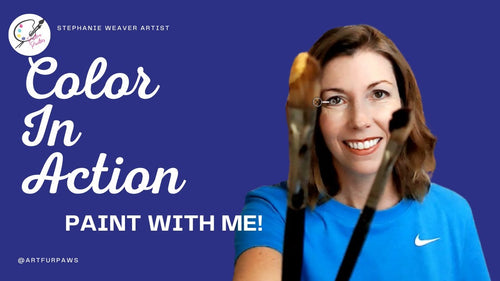One morning I was walking the dogs and right in front of my house on the sidewalk was this leaf - it was a perfect example of a red maple leaf, I backed up and picked it up and thought "I want to paint this". What drew me to it was its color and imperfections.

So I brought the leaf inside and took a picture. At that point, it moved to the back of my mind as a "I'll get to it" and I left it there...later that day, around lunchtime, I saw it again and noticed that it was shriveling up a bit.
Frankly, I was surprised at how quickly that happened. So I took another picture and left it there again. I didn't intend to paint 3 paintings...but the next day I saw it again, it was even more shriveled.

I took another picture. And it was at that moment I knew I had to paint all three - it was the evolution of the leaf that created a greater meaning for me about this simple, beautiful, imperfect/perfect leaf.
In this seemingly simple painting of a leaf, you will have the opportunity to paint the same leaf I painted OR watch the logic and techniques and apply the techniques to a subject that motivates you to paint in 3 different ways.
This painting uses the following oil painting techniques, (click on each to see all the definitions and corresponding courses that will help you perfect the oil painting technique):
- Alla Prima
- Glazing
- Scumbling
- Blocking In
- Blending
Paint Supplies
Video 1 - Palette Setup
Standard Color Palette
- Ultramarine Blue
- Cobalt Blue
- Sap Green
- Alizarin Crimson
- Burnt Umber
- Burnt Sienna
- Cadmium Orange Medium
- Yellow Ochre
- Cadmium Yellow Medium
- Titanium White
Additional Paint Colors
- Napthol Red
- Asphaltum
Reference Materials, Color Mixing Guide and Process Guide
Canvas
 I am painting my leaves on 3 8x8" Ampersand Gesso panels, because that is what I had and Ampersand is by far my favorite surface to paint on because of its:
I am painting my leaves on 3 8x8" Ampersand Gesso panels, because that is what I had and Ampersand is by far my favorite surface to paint on because of its:
- smooth texture,
- durability,
- versatility in framing options,
- and low storage space requirements.
Handy Tip: use your razor in the scraper to remove the protective wrapping. Be sure to slice on the BACK of the Panel, not the front.
Paint Brushes
I've preselected my paintbrushes based on what I thought I would need, and also to try out some brushes I haven't used before to see how they handle. Please refer to the reference materials for a listing of the painter brushes that I used in this painting.
In this painting I used:
- #3 Rosemary & Co Evergreen Long Flat,
- #2 Rosemary & Co. Kolinsky Sable,
- 3/8" Rosemary & Co Eclipse X Long comber,
- #4 Rosemary & Co Ultimate Filbert,
- #8 Rosemary & Co. Evergreen Long Flat,
- 1/2" Master's Touch Oval Mop and
- 1/2" Simply Simmons Round Mop Brush
Standard Palette Colors
The palette setup includes:
- Ultramarine Blue,
- Cobalt Blue,
- Sap Green,
- Alizarin crimson,
- Burnt Umber,
- Burnt Sienna,
- Cadmium Orange Medium,
- Yellow Ochre,
- Cadmium Yellow Medium
- Titanium White.
Additional Paint Colors
- Napthol Red,
- Transparent Earth Orange
- Asphaltum.
Oil Painting Mediums
The mediums that I'm using are:
- Gamsol,
- Galkyd and
- Neo Megilp.
Painting Color Mixes
I prefer to pre-mix some base colors that I see, I find this ritual helps me get into the painting and begin seeing it for the shapes and colors rather than the logic of the brain saying "it's a red leaf".
Here are the base color mixes that I put together.
Painting 1 and Painting 2:
Base Color Mix: Alizarin Crimson, Burnt Sienna, Cadmium Orange Medium
Darker Color Mix: in the first painting I see Ultramarine Blue, Alizarin Crimson
Sketching the Painting Mix: Burnt Sienna with Gamsol medium (brush cleaner)


Background Shadow Color Mixes: Sap Green, Asphaltum, Titanium White. Feel free to add in colors that you see. I added sap green, some of the red mix and cobalt blue.
Background Mixture to Soften the Shadows: Making another color mix of Titanium white with some Neo Megilp. Note: if it picks up some other colors, that will just add color harmony to the painting - no worries.

Green Stem and Green Accents Color Mix: Sap Green and Cadmium Yellow Medium
Painting 3:
Base Color Mix for Light Areas: Alizarin Crimson, Cobalt Blue
Darker Color Mix for Shadow Areas: Alizarin Crimson, Ultramarine Blue
Brighter Reds: I brought in Napthol Red in between the two darks to grab when I saw a brighter red.
Sketching the Painting Mix: Burnt Sienna with Gamsol medium (brush cleaner)
Background Shadow Color Mixes: Sap Green, Asphaltum, Titanium White. Feel free to add in colors that you see. I added sap green, some of the red mix and cobalt blue.
Background Mixture to Soften the Shadows: Making another color mix of Titanium white with some Neo Megilp. Note: if it picks up some other colors, that will just add color harmony to the painting - no worries.
Green Stem and Green Accents Color Mix: Sap Green and Cadmium Yellow Medium
Video 2 - Painting a Leaf Video Playlist - Painting a Series - 1st Leaf
Transcript
About the drawing
I'm choosing to sketch the painting free-hand using Burnt Sienna thinned down with my Gamsol (which is my brush cleaner) .
Because I didn't manually create a grid, I'm mentally outlining where the grid would correspond to the picture and to the canvas to start the sketch. The approach I'm taking is to outline a bit of one leaf, move to the top of another, and top of another - this way I'll ensure that the total subject is on the panel and keeping within the mental grid and proportions.
NOTE: you may draw this in whatever method you prefer (refer to the 6 methods of drawing to get a firm foundation for a painting).
Once I have the initial outline, then it is a matter of refining the sketch.
The veins of the leaf are important to me to map out, even though I know I'll paint over them, because they are telling me the topography of the subject, so I'll know where it reaches it peaks and valleys.
Blocking In The Leaf
Looking back at this painting and how I started, I was very tense - you can tell because I'm using a small brush and I'm not holding my brush towards the back of the handle….but I'm following the standard methodology to applying paint: I'm starting with blocking in the darks first.
My brush technique, I'm trying to move in the direction that the folds of the leaf move.
I have a few extra colors that are not part of my normal color palette that I'll grab: Asphaltum is a fabulous transparent brown. I Asphaltum mixed with Sap Green to the burnt-looking areas of the leaf.
Even in my Alla Prima approach I keep the first layer thin and remove the peaks of paint and create smooth transitions of color by using a mop brush to gently blend.
Using a clean brush with a bit of the Gamsol and paper towel in hand, I begin removing paint which is essentially lifting off paint. This technique enables me to draw the veins and re-establish the topography of the leaf. I start the lifting-off process at the lightest point of the vein.
Adding a bit of Titanium White to the red mix is what I see in the lighter areas of the leaf, as the leaf stands without it, there is too much of an intense red that while lovely, it not a realistic-looking leaf. and at this point, I am still working out the color that will work best for the lighter areas of the leaf.
Blocking in Background
I've got enough information with the leaf to identify the lights and darks, it is time to finish out the overal look by focusing on the shadows and background. You'll notice - this is when I FINALLY loosened up! I'm 20 minutes into the process and I finally loosened up.
Shadow Color Mixes: Sap Green, Asphaltum, Titanium White. I start by sketching in the core shadows. Adding a touch of cobalt blue and some of the base color mixes into the shadow mix will create a harmonious shadow that reflects all the colors.
Making another color mix of Titanium white with some Neo Megilp will enable me to paint the background and soften all the edges and core shadow AND mixing in some of the surrounding color - again making it a harmonious painting.
Notice how I didn't draw in the stem? That's because I knew that this detail would be one of the last pieces of information to paint in.
Before you start a painting, take a few meditative minutes and imagine yourself painting the painting. Mindfully walking through the process and the approach will help guide you through the most productive path.
In the background I used the 3/8" Rosemary & Co Eclipse X Long Comber - I really liked the brush stroke look so I decided to try that for the edges of the leaf as well.
Painting The Stem
For the Green Mix, I used Sap Green, Cadmium Yellow Medium and used the medium Galkyd, because I wanted the paint to stick to the previous layer, not mix with it.
Finishing Details
Adding some finishing details of defined edges really makes the leaf come off the paper and identify where it touches the paper.
Using the #2 Rosemary & Co Kolinsky sable to get the fine details, edges and shadows is the finish touch.
Video 3 - Painting a Leaf Video Playlist - Painting a Series - 2nd Leaf
Transcript
About the drawing
Now that I have a really good working knowledge of the color mixes, the structure of the leaf, and approach, the 2nd painting will appear to move more quickly.
I'm going to keep the original painting next to the one I'm working on to ensure that I'm keeping to the same harmony and structure.
Notice how much more quickly I'm able to sketch in the leaf?! While I was painting it the first time, my mind was capturing each piece of the leaf through intense observation and study. That's one of the many values of the montra Learn- Paint - Repeat.
Blocking In the Leaf
From the first round of painting, I recognized that I could go with a much larger brush to block in the shades: here I'm using a #8 Rosemary & Co Evergreen Long Flat.
Using a clean brush with a bit of Gamsol to lift off paint, I'll redefine the lightest areas of the vein.
In the first painting, I used the Rosemary & Co Comber for the edges. I felt like that didn't give the sharp edges like I wanted, so here I switched to the #3 Rosemary & Co Evergreen Long Flat and was much more pleased with the result. Experimentation is key, don't be afraid to try something new, if you don't like something - lift it off or blend it in, or even wait till it dries to try again.
Video 4 - Painting a Leaf Video Playlist - Painting a Series - 3rd Leaf
Transcript
Color Mixing
I move the 2nd painting to the right of the last one again to ensure harmony in color and placement.
The last leaf has much darker colors and more colors are being revealed in the curled leaves. So I mix a darker base of Alizarin Crimson and Cobalt blue for the parts that are still dark but are being hit by the light. And for the shadow areas of the leaves, I mixed Alizarin Crimson plus Ultramarine Blue. I also brought a bit of Napthol Red in between the two color mixes so I could just reach and grab and mix based on whether I wanted a cooler brighter red or a warmer brighter red (based on whether it is in shadow or not).
Blocking In The Leaf
Again using burnt sienna plus Gamsol I'm going to sketch the outline of the leaf.
The size brush I used in the 2nd painting was the winner for blocking in the colors for this size and subject - so here I'm using the #8 Rosemary & Co Evergreen Flat to block in the colors.
The underside of the leaves has a lot of color variation! I added a number of colors that I saw into the mix including Asphaltum, Alizarin Crimson, Sap Green, Ultramarine Blue, Cobalt Blue.
Blocking in the Background
Here I am adding the core shadow much more confidently because now I know that I'll blend the darks with white and that bringing in some of the reds into the white will create beautiful movement and harmony.
Blending
Notice how I'm using 2 different mop brushes - one for the whites and another for the reds. Now that the edges are nicely blended, let's define the hard edges with accented highlights and darks.
Finishing Details
Here I'm lifting off paint using Gamsol again - with this technique I'm able to create beautiful glows in the folds of the leaf that is dying off. Suddenly you can really see the fold in contrast to the darks of the leaf. Notice how I step back after almost every time I remove a bit of paint - this helps me see the bigger picture and not each and every vein and the time to clean my brush.
Because I really wanted to show how much the leaf is lifted off the paper, I used some titanium white to create hard edges under some of the highest points where the leaf is away from the paper and not casting a shadow.
Conclusion
If you're looking to expand your knowledge, improve your skills, or explore new interests, taking online classes is the way to go. The flexibility, wide range of courses, access to expert instructors, interactive learning experience, and cost-effectiveness make online classes an excellent choice. So, why wait? Start your online learning journey today by visiting my YouTube channel or joining me online or in person. Click here to take the next step towards your personal and professional growth!
Don't want to Paint it? You can buy it!
I personally buy people's artwork so that I can breakdown what they do - education never stops and this way I also support artists that I admire. You can do it too!
For More Information About Recommended Oil Painting Supplies, Gather This FREE ebook:






































